#difficult economic conditions
Text
theres zero contradiction between social welfare for the citizen and brutality for the non citizen idk why people pretend there is. its great for the us to destroy any attempts to improve labour conditions in the third world bc it keeps consumer prices low for them to import. its great for the us that the rest of the world remains desperately poor and/or bombed out so they'll attempt to flee to the us and work shitty jobs on temporary visas if even that and put up with precarious labour conditions. its great for the us to have a lever on oil prices by having an outpost in the middle east to exert influence on rogue parties.
the us military isnt so big bc lockheed martin likes rentseeking and it creates a jobs it has a much bigger economic purpose: to give the us power that remains difficult to challenge – nobody can touch israel as long as the us backs it.
2K notes
·
View notes
Text
Where does Saturn hit you hard?
Saturn in 1st: Not so much bad but sometimes can hurt your confidence and health, but a position that is not too damaging.
Saturn in 2nd: Pretty bad, can indicate being born in harsh conditions, economically bad family, lack of family support, can hurt your ability to earn high later.
Saturn in 3rd: Hurts your adolescence years, your schooling and communication but is not damaging after 22-23.
Saturn in 4th: Hurts your childhood and parental support, middle phase of life can be difficult with no real happiness.
Saturn in 5th: Hurts your romantic life and even your ability to have and enjoy children and fun.
Saturn in 6th: Not a bad position but can hurt your ability to innovate at work.
Saturn in 7th: Pretty tough, hurts your relationships, denies or delays them, a bad partnership.
Saturn in 8th: Hurts your ability to benefit from other people, sometimes poor in laws and also inability to change your life. Limits your sexuality.
Saturn in 9th: Hurts your higher education, pretty much no luck in life, lack of paternal guidance in life.
Saturn in 10th: Limits your ability to rise to the top, unreal downfall.
Saturn in 11th: Dries up your friendships, bad friends and social isolation.
Saturn in 12th: Not bad materially but many emotional and psychological troubles.
For Readings DM
#astrology#astrology observations#zodiac#zodiac signs#astro community#astro observations#vedic astrology#astro notes#vedic astro notes#astrology community#saturn in astrology#saturn#saturn in houses
2K notes
·
View notes
Text
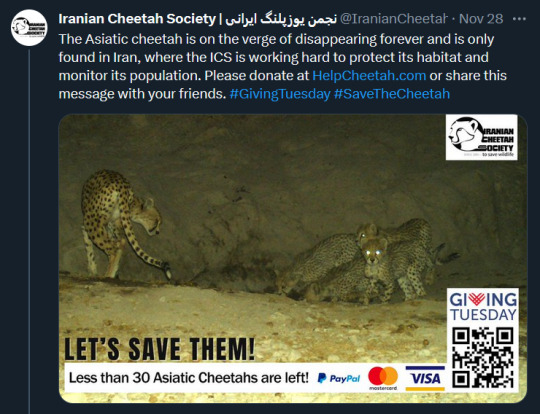


"The Asiatic cheetah is on the brink of extinction due to worsening conditions. Unfortunately, wildlife conservation in Iran is not a top priority for the government, which is under intense pressure from sanctions. These sanctions not only affect the government but also the livelihoods and employment conditions of the people across the country. Companies and factories are going bankrupt, and their workforce is being downsized. As a result, it is becoming increasingly difficult to keep experts at non-governmental and non-profit organizations that are dedicated to preserving wildlife.
Individuals are forced to migrate from hope to despair to sustain their paths of career growth and prosperity for themselves and their families. The Iranian Cheetah Society (ICS), which used to have over 50 members, now manages all conservation, educational, and advocacy activities with only six individuals. Among them, we manage to pay a modest salary to only one person and struggle intensely with a shortage of manpower and budget. In the past year alone, three key members decided to migrate. If we are to dedicate more time and resources to the conservation of the Asiatic cheetah, there is no solution other than preserving the few remaining workforce. It is important to note that extinction won’t wait for political issues to be solved.
The current supporters of the ICS have somewhat assisted in keeping ongoing conservation activities in the field, despite sanctions and economic hardships. However, the lack of sufficient manpower for field deployment renders project budgets futile, no matter how much they increase. Therefore, this year, we intend to request assistance for covering the salaries of our conservationists and aim to secure project costs from larger institutions throughout the year since they are generally uninterested in covering human resource expenses.
According to our estimates, by Giving Tuesday next year, each full-time expert will incur at least 4100 euros in expenses. This amount covers only the salary and does not include insurance and other expenses, which we hope to obtain from other sources. With every 4,100 euros, we will be able to contract a full-time force for one year. We hope to raise a minimum of 8,200 euros from Giving Tuesday to International Cheetah Day this year. You can also contribute by securely donating money through PayPal at HelpCheetah.com or by sharing this message with others, helping us remain hopeful for preserving the Asiatic Cheetah."
- The words of Iranian Cheetah Society CEO Morteza Pourmirzai.
Donate | Learn more
1K notes
·
View notes
Text
clauses, clashes: debater!yuu || heartslabyul, savanaclaw

riddle rosehearts
"[name] is an excellent debater. i enjoy starting debates on any topic, be it law, morality, religion, education, or livelihoods, as they are well-informed about the happenings of both their and our worlds. it is a pleasure to talk to them and indulge in their debates regardless of the topic. one time, i did see them ask leona about the economic situation in the sunset savannah so they could prove a point. they are quite fearless."
trey clover
"[name] being a debater is nothing new, if you've ever heard them talk. they love debating with riddle and azul, it gives them a lot of information about twisted wonderland, and they keep themselves and the top students of the second year in check, if you get what i mean. overall, i don't really mind how loud and decisive they can get sometimes, but how much they know and can discern does shock me."
cater diamond
"yep, i heard about [name]-chan being a debater, but i thought of it as some weird rumours until i saw them debating about climate or something with riddle, i don't even know what it was till today. they're intelligent, well-aware... i mean, what else does the ideal student look like?! they're also somehow one of the top 10 in the first years, maybe because they've already been through a few years of schooling in their own world? woah!"
ace trappola
"haha, [name]'s scary, the way they look when they're debating, i mean. they get fierce and stuff, and then they launch with rapid-fire facts and questions that make it difficult for any normal dude to answer. only people i've ever seen answer them right away are riddle-senpai, azul-senpai, and leona-senpai. takes guts and some recklessness to be fighting them with words, but maybe they're doing something i'm not, since they're scoring well. should i try debating with riddle-senpai too?"
deuce spade
"[name] is super scary and awesome when they're in debater mode. i'm being serious, stop chuckling! one time, they walked up to malleus draconia himself and just launched into conversation! i don't even know what it was about, but he looked so confused before smiling and nodding to whatever they were saying. no wonder they're in the top 10 all the time... their academic sources are terrifying."
leona kingscholar
"the herbivore being a debater's real interestin', to be honest... i haven't seen many people who can speak confidently about a variety of topics like they can. they came to me once, asking about the economical condition of the sunset savannah in the last decade. couldn't tell 'em much, but they insisted i helped. weird kid, roamin' around so freely in the lion's den..."
ruggie bucchi
"[name] is super cool, y'know?!?! heard them debatin' with azul once in the mostro lounge, over over-prized foods 'n' drinks and why that would hurt business in the long run. safe to say azul listened to 'em and brought his prizes down by a bit, and suddenly we're all busier than expected, especially then they mentioned delivery apps and discounts that allowed stores in their world to connect with customers all over the globe. sounds interestin', don't it? the best part is, i can finally afford 2 coffees a day at the lounge with the leftovers of whatever leona's paying me, shishishishi!"
jack howl
"i did hear that [name] was good at debating, but i've yet to see it for myself, you know. it's a shame that nrc doesn't participate in such competitions, otherwise they'd be able to shine here too, build some sort of a reputation other than just "the magic-less human", you know? they're well-learned with the capacity to learn more, but the way that they hyperfocus and absolutely zone out sometimes is terrifying."

request by @red-viewe: Hi soru! can i request like hcs on a mc/reader who is rlly good in debating? And like how savannaclaw and heartstahyul would react? Take ur time ofc and make sure to take care of urself!! -red❤
#twisted wonderland#twisted wonderland x reader#twst#twst x reader#riddle rosehearts#riddle rosehearts x reader#twst riddle#trey clover#trey clover x reader#twst trey#cater diamond#cater diamond x reader#twst cater#ace trappola#ace trappola x reader#twst ace#deuce spade#deuce spade x reader#twst deuce#leona kingscholar#leona kingscholar x reader#twst leona#ruggie bucchi#ruggie bucchi x reader#twst ruggie#jack howl#jack howl x reader#twst jack
316 notes
·
View notes
Text
A newspaper in my country has interviewed Siddharth Kara, one of the experts on what's going on in the cobalt mines in Congo. I think it's very well explained and a must-read to get an overview of this huge human rights violation that is going on. So here I translate it to English, hoping it will reach more people.
Siddharth Kara: "Every time we buy a new mobile phone, we put our foot around the neck of a child in the Congo"
Interview with the author of Cobalt Red: How the Blood of the Congo Powers Our Lives
"The poorest people in the world, including tens of thousands of children, dig the earth in toxic and very dangerous conditions to find cobalt," says journalist and writer Siddharth Kara (Knoxville, Tennessee, USA, 1974). The rechargeable batteries of our mobile phones, tablets, laptops or electric vehicles need this mineral that thousands of children, men, women and elderly people extract from the Congolese mines in inhumane conditions. Kara went there because he had specialized in research on slavery, and in Congo he found a modernized form of slavery. "Time has passed, but the colonial mentality has not," he explains. Everything he saw there and what was explained to him is recounted in Cobalt Red: How the Blood of the Congo Powers Our Lives (a book that does not have a translation into Catalan, but which has now been translated into Spanish, by Capitán Swing). The photographs and videos illustrating this interview were taken by himself.
—Was it difficult to write this book?
—Yes. Firstly, because of the specific difficulty of this area of the Congo: very dangerous, very militarized. There are armed militias. And for the local people there it is dangerous to talk to foreigners, because it can bring them consequences. It was difficult to get there, and then it was difficult to build trust with the people who worked there. I only managed it thanks to this trust, which we achieved little by little, until we were sure that we could do the research with guarantees and ethically.
—What drove you to the Congo cobalt mines?
—I had been doing research on slavery since 2000. Around 2016, some African colleagues contacted me and said: “Siddharth, something terrible is happening in the cobalt mines of the Congo, maybe you should go there”. I had no idea what cobalt was. I thought it was a color used for painting. I didn't know it was used for rechargeable batteries. It took me a couple of years to grasp its importance. Then I started making contacts to travel there, and in the summer of 2018 I went there.
—And what did you find there?
—The suffering and degradation I saw there were so intense that I decided to return there often to write a book. Hundreds of thousands of the world's poorest people, including tens of thousands of children, dig the earth in toxic and very dangerous conditions to find cobalt and put it into circulation, in a distribution chain that goes to the rechargeable devices and cars that people like you and me use every day. It was a human apocalypse, a total invasion of human rights and the dignity of the Congolese people.
—Could you describe what a mine like this is like, physically? How should we imagine it?
—Those who are at the top of the economic chain of cobalt exploitation like to distort the truth, and use the term "artisanal mine". This way, they evoke a kind of picturesque activity, but on the ground it is a dangerous and degrading job. A mine of this kind is a mass of tunnels, pits and trenches filled with thousands of people who dig with shovels, pieces of metal or directly with their bare hands. They fill a sack with earth, stone and mud. Some children rinse it in toxic pools to separate the mud from the cobalt stones, which a whole family pours into another sack. It might take twelve hours to fill a forty-kilo sack or two. For each sack they get paid a few euros, very few, and that's how they live every day. They survive.
This video was filmed by Siddharth Kara: [you can watch the video in the interview link, freely available without any paywall, here]
—Is there any rational organization in these mines? Is there someone who decides who does what to optimize work?
—Well, there is a whole gear designed so that the poor and the children of the Congo produce hundreds of thousands of tons of cobalt every year. There, work is usually divided by age and gender. Digging tunnels, which requires a lot of strength, is usually done by young men and teenagers. The digging of small pits and trenches that can be less meters deep is done by women and smaller children. Rinsing this toxic cobalt is usually done by the children. The merchant system to exploit these families and sell the cobalt they produce to the formal industrial mines is very well set up.
—What else do these people at the top of the chain invent?
—Another fiction they invent is that there is a difference between industrial and artisanal mining, and that they only buy from the industrial one, where there is no child labor. Not true: all cobalt is mined by children. All the cobalt that the children and peasants extract goes straight to industrial mining. In addition, there is no way to separate what comes from a bulldozer and what comes from a child, once it all pours into the same place in the facility that does the industrial processing before this cobalt is sent out of the Congo.
—You explain that the situation is particularly abusive for women.
—Yes. It is a lawless land, and violence is the norm. Women and girls always bear the brunt: they are victims of physical and sexual violence, and almost no one talks about it. It is a major tragedy: they are victims of sexual assaults that are committed in the mines themselves, while they collect the cobalt that we have in our mobile phones.
—You refer to all of this as a new episode of slavery. It is not the first time that the Congo has a decisive material for Western economic development. It happened with uranium for nuclear bombs, for example. History repeats itself.
—Exactly. It is important for people to understand that we are not witnessing an isolated case, but the latest episode in a long, very long, history of looting of the Congo, a very resource-rich country, dating back to the colonial period. The first automobile revolution required rubber for tires. The Congo had one of the largest rubber tree rainforests in the world. King Leopold [of Belgium] deployed a mercenary army of criminals and terrorists to enslave the population and make them work to get it. This inspired Joseph Conrad's novel Heart of Darkness. The Congo also has abundant reserves of gold, diamonds, nickel, lithium and other metals and minerals that make components for electronic devices…
—These mercenaries deployed by King Leopold, are they still there today, in one way or another?
—Yes. On the ground there are militias, or the army, or private security forces that the mining companies hire and that, sometimes, in addition to monitoring, do the work of recruiting children. Under the threat of an occupation, they force an entire town to dig. It's atrocious: we live in an age of supposed moral progress, where everyone shares the same human rights, and yet our global economic order has its knee on the necks of the children and the poor of the Congo, with this huge demand for cobalt that has to fuel the rechargeable economy.
—Has no Western country or international body done anything to stop it?
—No. No western country, no government, no big business has lifted a finger to address this tragedy. They talk about maintaining human rights standards in their supply chains, they talk about environmental sustainability, but it's only talk. That is why it is very important that journalists and researchers set foot on the land of the Congo and listen to what the Congolese have to say: that no one protects their rights or their dignity, that they are erasing the environment, that mining it is not done in a sustainable way and the whole countryside is polluted and destroyed by the mining operations. It is enough to walk ten minutes around a mine to see it.
—Does the same happen in all mines? Large Western companies that use cobalt often claim that theirs comes from artisanal mines that meet standards.
—Have they gone there? There is no decent mine in the Congo. It does not exist. I'll be happy to take any CEO of any tech company to their mines, where their cobalt comes from. We'll stand there, watching them extract it, and take a selfie with it. Everyone will realize that what is seen behind us is not decent. You will see destruction, millions of trees felled, installations that emit toxic gases that fall on the surrounding towns, on the children, on the animals, on the food. There is no decent mine in the Congo. And they know it. But who will believe the voice of a Congolese if they can drown it out with proclamations of human rights while they continue to make money without measure?
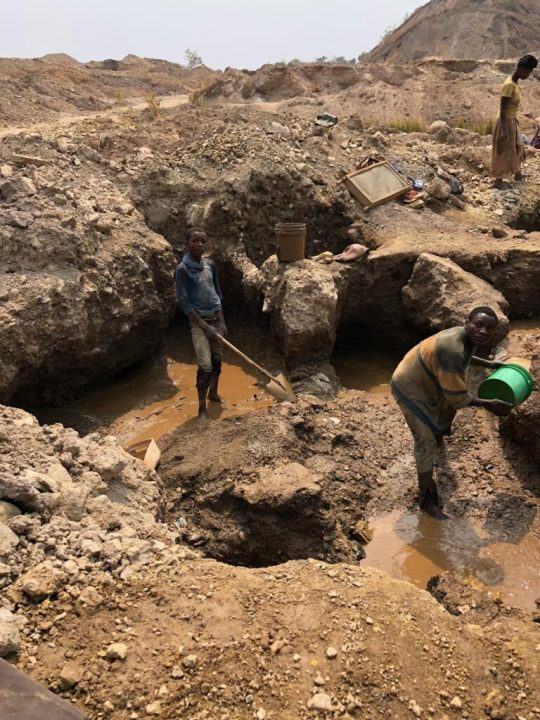


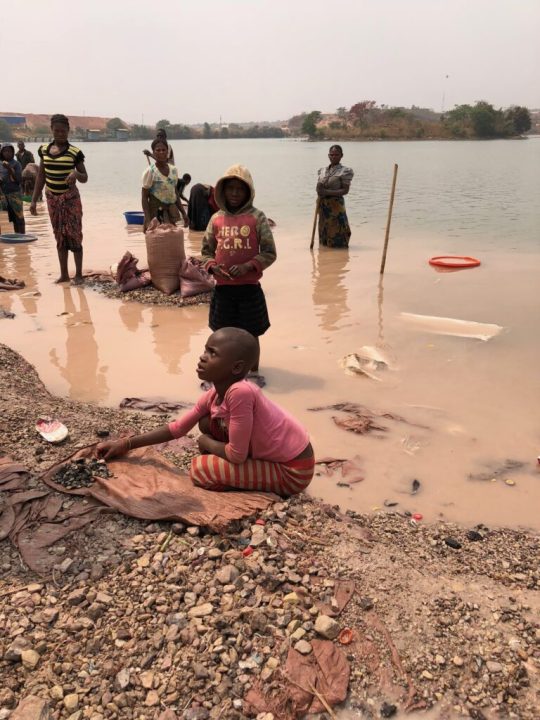
—Can you explain the role China plays in all of this? You say that it controls the supply chain.
—Yes. China controls about 70% of mining production in the Congo. Why do we accept China saying its mines are decent, if they don't even protect the human rights of their own people? Why do we accept a technology company or a car manufacturer saying, "My Chinese partners say they protect human rights there, and that's enough for me"? Why do we accept it?
—Why do you say that a certain transition to green energy is absolute hypocrisy?
—When the calls in favor of this transition consist of proposing to consumers that they buy electric vehicles instead of gasoline cars, this is hypocrisy. Because the cobalt and other elements that are used for the batteries of these cars are extracted using methods that are catastrophic for the environment. While in one part of the world we say we want to save the environment and leave a greener planet to our children, in another we are destroying both the planet and the future of their children. How can you save only part of the planet, turning the rest into a toxic dump? How can we give a green planet only to our children, while we let other people's children die? This is hypocritical.
—It is a reflection of the domination that the global north maintains over the south.
—We have never given Congo the opportunity to benefit from its own resources. It is a colonial mentality: time has passed, but the colonial mentality has not. It is the same type of colonial plunder from a century and a half ago. It is colonial to say: "Look, we need this, they have it, we take it from them in any way and, when we no longer need it, we leave a catastrophe behind us". There are companies that, recently, have started to pretend that they are becoming aware of this and promised that they would try to use batteries that did not have cobalt, but in reality they said: "Well, we've been caught, we'll look for another mechanism". And they do nothing to solve the catastrophe. Even if we no longer needed cobalt tomorrow, we would have to repair the destruction we have caused these past fifteen years.
—It's the big companies who should be required to react, but what do you think a Western consumer who has gotten upset reading you could do?
—The first step to progress in the conquest of human rights is always to make injustice known. Contribute to make everyone knows. Most people are good and, in their hearts, want no part of injustice. It is the few who move based on avarice and greed who pollute the rest of humanity. Outreach and awareness is the first step because it will inevitably activate a lot of people. Change always starts like this. In the case of cobalt, the second step is to think about our consumption habits. Every twelve months, the technology company I bought my phone from offers me a new one. Do I really need it? Every time we buy a new mobile phone, we put our foot on the neck of a child in the Congo. Better think twice, then.
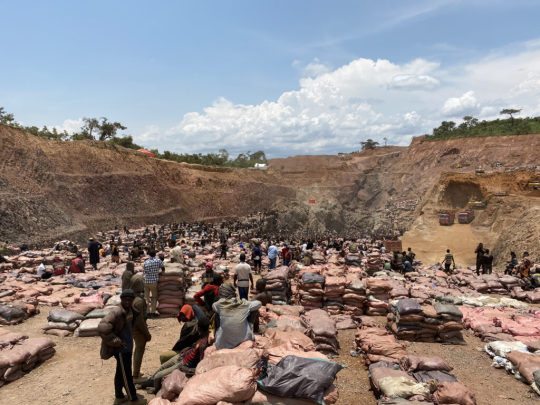
#congo#human rights#electric vehicles#electric cars#colonialism#labour rights#china#environmentalism#rape culture#feminism#slavery#africa#cobalt#labor rights#anti racism#free congo#siddharth kara#childrens rights#history#💬
178 notes
·
View notes
Text
Links for donations to Sudan
UNHCR ACNUR: People are being forced to flee amid fighting and refugees are arriving in neighboring Chad in desperate need of help.
UNHCR, the UN Refugee Agency, is on the ground assisting newly arrived refugees and providing life-saving support.
CICV: Health care could collapse at any time, despite the best efforts of Sudanese health teams, who continue to work in extremely difficult conditions, caring for injured people and providing other essential services to the population.
There are severe shortages of water, energy, food and essential medical supplies.
Sudan Relief Fund: CRISIS APPEAL: Nearly 7.1 million people displaced in Sudan. Destruction of healthcare facilities, disruption of critical healthcare services like immunizations, newborn care and availability of healthcare workers is putting many at risk of death and life-threatening complications. We need every bit of help in generating a relief fund to continue our efforts in Sudan.
Sudanese family of 8 struggling to escape the War.
Emergency response in Sudan: UNICEF continues to call for an immediate ceasefire across Sudan, and reiterates its call for all parties to the conflict to respect international humanitarian and human rights law – including ensuring that children are protected – and that rapid, safe, unimpeded humanitarian access to children and families in affected areas is facilitated. Without such access, critical lifesaving humanitarian support will be out of reach for millions of vulnerable children.
Despite the challenges, UNICEF and partners have provided life-saving assistance to more than 6 million children inside Sudan and in neighbouring countries, including water, health, nutrition, safe spaces and learning.
Sudan: A deepening humanitarian crisis: Sudan has plunged into a conflict of alarming scale, leaving half of the population in need of urgent assistance to survive.
This comes on top of existing challenges including economic hardship, disease outbreaks and climate-related hazards.
Families are struggling to access water, food, fuel, and other critical commodities and they need urgent help.
Be a lifeline to Migrants in need: With almost 25 million people - half the population - in need of some form of aid, the situation is particularly dire for the more than 7 million people displaced within Sudan.
Periods Don’t Stop for War! Stand with Sudanese Women and Girls: They Need Your Help Now!: SIHA Network will partner with the PNDS (Fawta Tsed Alkhana – Pad Needed, Dignity Seeded) Initiative and Sustainable Development Response Organization (SUDRO) on a campaign to collective donations and use them to buy and distribute the crucial menstrual dignity kit items Sudanese women and girls desperately need right now.
Through providing menstrual products, the risk on women and girls’ health can be decreased and their well-being can be improved.
You can also donate to MSF International here and for MSF Sudan here.
165 notes
·
View notes
Text
Happy National Zookeeper Week!
I’ll admit, I’m feeling a little spicy about it this year (well, every year) because zoos use the celebration for lots of positive facility PR, yet staff don’t often get the support and respect that is claimed in those posts.
So I want to share this great article written by a zoo industry consulting group last year looking at the reality of what happens when a workforce ends up conflicted between their passion (zoos and animals) and pragmatism (paying rent, existing in a capitalist society). They assessed AZA compensation rates by region against things such as a living wage and rental rates in the area. (All text formatting within quotes, such as bold and italics, is original to the article text.)
I cannot give the Canopy Group enough support for the way they framed this research:
“By observing the economics of keeper compensation, it’s no secret that keepers land on the lower end of the wage spectrum. Like all other wages and salaries, the market value of keeper compensation is driven by several economic factors – including the size of the labor pool, the rigor and danger of the work, the technical ability required, and the educational requirements. However, there is one factor that artificially lowers the market value of keeper compensation more than any other: passion.
In this article, we’ll take a look at why passion lowers the market value of animal care worker wages. More importantly, we’ll consider many factors that have emerged in recent years that are making people reevaluate the value of following their passion – a trend contributing to The Great Resignation, especially as it applies to zoos, aquariums, and similar organizations. (…)
The argument here is passion versus pragmatism: the unknown versus the sure thing. It is a decision all zookeepers and animal care technicians have made. Working with animals is immensely rewarding, but this passion is also very popular. This, historically, has meant that the keeper candidate pool is very large. Therefore, if the wage is livable and working conditions are reasonable, the pool should remain large. In a very real sense, a passion for animals drives down the market value of keeper compensation. Anyone who has been through an Economics 101 course will recognize this as a fundamental market principle: supply vs. demand.
However, many zoos and aquariums are having a more difficult time filling positions than normal and have started to see higher turnover rates in recent years. This begs the question – is the current keeper wage too low?”
Their findings?
Here’s their graph of “the median wage of keepers from organizations in different AZA-defined regions” from an AZA survey done in 2021. (Median is the type of average that looks at the middle of a data set’s range).
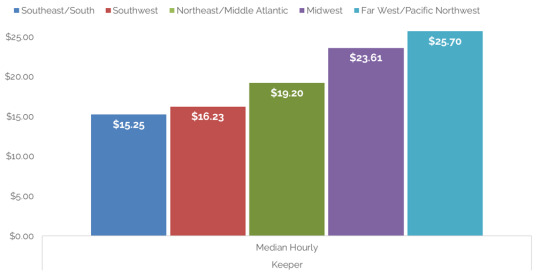
The median wage for AZA keepers in the South/Southeast was just over $15/hr at the low end, and the median wage for AZA keepers in the Far West / PNW was a little under $26/hr. That’s pretty dang low everywhere, especially when you factor in the increased cost of living in places like the West Coast. Also consider that looking at the median wage doesn’t mean this reflects just entry-level compensation - this data indicates the the compensation middle for all keeper positions, including people who have built their careers as keepers in those places long-term.
Then, they compared those wages to the “living wage” in each region - which they defined as “a calculation of what it takes to live in a particular area, without any other income. A living wage calculation takes into consideration how many earners are in a household, how many children are being supported, etc. The living wage includes the costs of all the basic items a household needs to be self-sufficient.”
“If you receive a wage for a job that is below the living wage, then you are essentially taking a negative net income. This is unsustainable for the long term, and essentially defines where wages start to exploit passion.”
Here’s a figure they provided using the MIT Living Wage Calculator showing the average living wage for each of the AZA regions. The chart on the left shows the living wage for a single person with no kids; the second, for two parents with two incomes and one child to support.
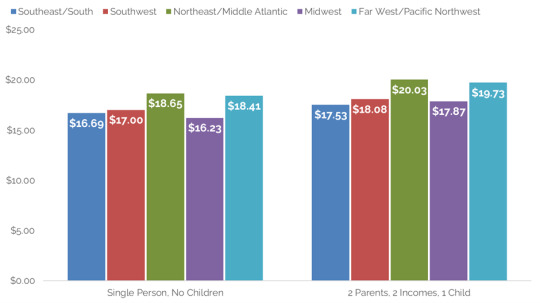
“By comparing the two graphs [to the earlier graph of the AZA median compensation rates], we find that median wages in the Southeast/South and Southwest regions are lower than the living wage for each household configuration in those regions. In other words, if you are a single person household or part of a two-income household raising 1 child in the South, a starting keeper salary will likely leave you with a negative net income. While many people work at this level, it increases the risk of accumulating debt, lowers a person’s ability to afford a home, set a much later retirement age, and can lead to many other negative, long-term effects.”
Big yikes, right?
Next, they looked at living wage vs. compensation for single parents.

“The single-parent living wage exceeds the average keeper wage in all AZA regions. In fact, the living wage required as a single parent is double the average AZA keeper wage in some regions.”
And then they did housing, specifically, being able to purchase a home.
“In many places, even a two-income household at an average keeper salary would not purchase a mid-level home. This means that keepers have to wait far longer than their peers to purchase a home. While paying rent in the meantime, this rent will account for a larger portion of their income than their peers. All in, these effects can set hopeful homeowners back years or decades.”
Canopy’s conclusion was something anyone involved in the field knew was coming.
“Companies like Chipotle, McDonalds, Best Buy, FedEx, Home Depot, Publix, and Walmart are all offering similar starting wages near starting keeper wages – plus many fringe benefits (like tuition reimbursement) and ample advancement opportunities. Many potential keepers in younger generations are putting their passion on the shelf so they can meet basic standard-of-living concerns.
To attract and retain quality candidates, an organization must consider the journey each new employee would have to make over their career. If the journey is fraught with massive debt, decreased disposable income, and limited career opportunities, then you are limiting your potential candidate pool to the small group of people who have decided that following their passion is worth significant lifelong financial hardship. There are many potential candidates out there willing to sacrifice and arm and leg for animals and conservation, but they wouldn’t dare jeopardize the financial future of their dependents and families.”
This is something I’ve heard about for years, and seen first hand. The low average wage at zoological facilities has been damaging their ability to hire and retain skilled staff for as long as I’ve been involved in the industry. I know so many zookeepers who still have roommates into their 30’s, or work multiple jobs, just to be able to make ends meet.
There’s a mythology about zookeeping jobs, a narrative that seeps into the field and actively exploits people’s passion for the job: it tells people that they’re so lucky to be able to work with these rare and cool animals; that they’re greedy and ungrateful when they ask for more compensation because they’re privileged to get to have the job at all. It says that most people would give anything to have these opportunities, so current zookeepers are interchangable and easily replaceable. Ask for too much? Push for a living wage? There’s always someone willing to take your spot. Not all facilities perpetuate this mentality - some places do treat their staff well without intentionally manipulating them to stay them in unsustainable jobs, and there can be legitimate financial reasons that limit staff compensation (mostly at smaller facilities, afaik) - but it’s a reality in the field.
For a long time, this type of mentality towards staff was sustainable. There really were always more people wanting to work in the field. But now, after three years of pandemic stressors and inflation, it’s starting to be a problem. A lot of staff left during the last few years, and facilities are having a really hard time hiring people and retaining them for any duration. I think a large part of that is low compensation rates. People are prioritizing long-term financial stability and recognizing when their passion is being exploited.
When I first started on tumblr back in 2011, there was a whole group of us within the United States who were baby zookeepers or volunteering as industry hopefuls. We all became friends, and I’ve stayed in touch with, or at least aware of, most of them as their careers progressed. Of the 10-15 or so people in that cohort? I can think of three who are still employed in the zoo industry. Everyone else has moved on into other fields - often with great grief over the loss - because of the extreme emotional labor, the physical exhaustion, and the lack of appropriate compensation.
But I guess that annual pizza party, being featured on social media, and maybe getting additional snacks all week makes up for it all?
#national zookeeper week#zoo industry#living wage#compensation#please support your local zookeeper#AZA accreditation#AZA zoos#zoos
555 notes
·
View notes
Text
The immediate impact of the Israeli occupation was to exacerbate unemployment: service jobs for the Egyptian army and UN forces vanished, trade with Egypt halted, and the port was closed. Moreover, since the combined GNP of the West Bank and the Gaza Strip was only 2.6 percent of the Israeli GNP in 1967, they faced inevitable integration into the Israeli economy as the occuption continued. Furthermore, Israeli policies increased the Strip's dependency. These practices included permitting only certain Gaza products to be sold within Israel, flooding the Gaza market with Israeli goods, restructuring Gaza's agriculture, and encouraging Arab laborers to work in Israel.
The Balance and Composition of Trade. After only one year of occupation, 72 percent of Gaza's imports came from Israel; no imports were allowed from Egypt, and 1 percent of its imports came from Jordan (the balance came from Europe). This represented a dramatic shift, since all the prewar trade had been either directly with Egypt or with Europe and Asia through the Gaza port. [...]
A decade later the shift in trading patterns was even more pronounced. [...] 91 percent of imports came from Israel, and nothing was imported from Jordan or Egypt. [...] Dates, strawberries, and vegetables were also sold to Israel, and local industries engaged in subcontracting for Israeli firms.
Agriculture and industry were both hard hit by Israeli competition. Israeli eggs, poultry, and even vegetables sell at lower prices than local produce, and virtually all canned and bottled goods come from Israel. [...]
A 15 percent excise tax and soaring inflation erode the profits of merchants and factory owners. Gazans have no way to hedge against inflation, since the Israeli shekel is the only legal tender on the Strip.
Restructuring Agriculture. Israel has prevented farmers from exporting to Israel any items that compete with Israeli produce and has imposed restrictions on the planting of certain crops. As a result, the output of melons, onions, grapes, almonds, olives, and fish has decreased. Farmers need permits to plant trees and vegetables.
[...] The government has encouraged production of some specialized crops, such as strawberries and dates. Farmers in Beit Lahiya village say that they were ordered to grow strawberries and would otherwise have been prevented from using their land and well. These strawberries are marketed exclusively through Ashkelon port by the Israeli export firm Agrexco. No permits, however, have been given to farmers to plant such crops as mangoes and avocados, which are also grown in Israel.
Arab Labor in Israel. In 1970, 10 percent of the Gaza labor force was employed in Israel, but at present approximately 40 percent (35,000 persons) work there. This includes 25,000 workers who are registered with the official labor exchange and another 10,000 who work illegally. The high unemployment within the Strip and the fact that wages inside Israel were five times those in the Strip made such employment irresistible.
[...] Even those holding regular jobs face difficult conditions. For example, it is illegal for them to remain inside Israel from 1:00 a.m. to 5:00 a.m. But employers and workers collude in circumventing the law so that the workers will not have to spend several hours every day commuting. Farmers let laborers sleep in huts, abandoned buses, or even in the open under the orange trees. In town, workers jam into hostels, sleep on construction sites, or spread out on the floor in restaurants. There have been cases of disasters when workers locked into factories at night were unable to escape when fires broke out. [...]
The overall impact of Israeli economic policy is to turn the Gaza Strip into a large labor camp. The Strip is a source of cheap labor for Israel and its internal economic base is continually eroded.
– 1985. Ann M. Lesch, "Gaza: Forgotten Corner of Palestine." Journal of Palestine Studies 15.1, pp. 43-61. Emphasis mine.
212 notes
·
View notes
Text
Fashion in Fódlan: a very long, non-comprehensive, and entirely unsolicited analysis
The fe3h writers did a pretty solid job of creating three nations with clear social, economic, and political differences. The fashion stands out to me as doing exceptionally well at expressing those differences, and, just like in the real world, it works as a sort of socioeconomic barometer that helps tell Fódlan's story.
In this post, I'll break down the key clothing trends in the three regions and provide some light interpretations, largely related to $$
Please note that I'm NOT using this post to discuss historical inspirations. Also, not everyone from every region is included. In particular, anyone whose outfit is too much of just a riff on a class uniform (like the Ashen Wolves or the various minsters in the empire) is left out.
There's a part 2 now lol (church of seiros time); part 3 as well!
1. Holy Kingdom of Faerghus: function IS fashion, baby!!
Fearghus, beloved land of ice and snow and spooky folktales about watering your fields with blood and ghosts living under the ground - you did not come to fuck around. You're here to protect the commoners and go back home to a stew that may, if you're lucky, actually have some meat in it. In this kingdom, you're going to dress warm and you're going to like it. Oh, you have some extra money? Gonna spend it on something for yourself? Better be using it for something useful, like keeping your plate armor in good condition. (Please note: Catherine, though being Faeghan, is excluded because she wears the uniform of the Knights of Seiros, not her own clothes.)

Trends:
High collars, long skirts - generally as little exposed skin as possible. (There is exactly one pair of bare hands in the entire kingdom. Mercie is getting a little bold 👀)
Fur cloaks/capes/gloves, or just fur around the cuffs and collars if they don't have a full fur cloak.

Armor - every single man is dressed in armor, as is Ingrid. Most of the men have full suits of plate armor, but Felix, Rodrigue, and Ashe are wearing only gambesons (note the quilting in Felix's sleeve - that's what gives it away, imo). The folks in plate armor would have gambesons on as well (you can see Ingrid's underneath her breastplate), acting as padding for the plate armor. I think Gilbert is wearing plate armor with a tunic over it (a realistic historical practice).

Fastening is accomplished with clasps and lacing, and there are relatively few buttons or adornments to be seen on the main garments - Annette is an exception, which will be addressed later.
Brief analysis:
Notice the economical use of fabric - their clothing tends to lie flat, with fabric being layered for warmth rather than pleated, gathered, or puffed. The folks in plate armor may spice it up a little with a sash of some kind if they aren't already wearing a cloak or cape. I'm assuming Gilbert's ~stylish tunic~ is keeping him warm well enough to not need a cloak or larger scarf. (Mercedes has a ruffles and puffier sleeves, plus a fuller skirt, but it's worth noting that she is currently part of a merchant house, and merchants tend to be wealthier and actually occupy a unique social class between nobles and commoners.)

Note the colors, too. Greens, browns, and yellows are the cheapest and easiest dyes to make and use. That bright sort of tawny color that Gilbert, Annette, and Jeralt all have is easy and cheap. Gilbert's grey tunic could feasibly just be undyed wool. A true blue is difficult, but you'll note that the blue the people wear up here leans towards grey and green - could be that the dye is faded, or that it was never very blue to begin with. The only true blue is on Dimitri.
All of this reinforces the idea that Faerghus is not a rich nation, and the nobility don't live too far off from the common folk. The vast majority of the cost we see is actually their armor (worn by Dimitri, Dedue, Sylvain, Gilbert, Jeralt, Matthias, Ingrid, and also if we're getting all the way into it, Gwendal, Miklan, Lonato, and Baron Dominic as well), which is would have been pretty expensive. You'll notice they mostly wear grey armor with very little extra decoration, keeping the costs low. Ingrid, the poorest of the nobles in armor, also has the least actual plate. Felix and Rodrigue both have full cloaks, which most other people don't have (just Dimitri), but they also aren't wearing plate, so clearly that's a calculated choice.
That being said, even within these more economical fashions, we can still see clear differences between classes. Most noticeably, Felix (rich) and Ashe (not rich) have very similar outfits, but Felix's tunic/gambeson is lined with fur, while Ashe's is not.

BTW I'm of the opinion that the Fraldariuses are the richest people in the kingdom other than the royal family, and I believe that specifically of their fancy cloaks lol
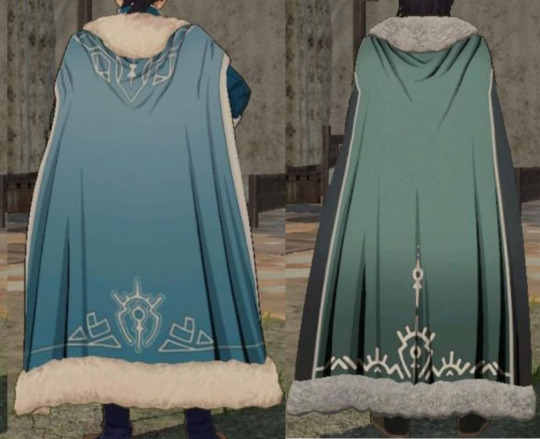
so luxurious~
2. Adrestian Empire: look at my money bitch
Ah, the land of beauty and excess! I love to live in the capital and visit the cultural icon that is the opera and pretend that I'm not in Wealth Inequality Central. (Please note: Petra is not included, since she dresses according to Brigid's fashions. Also note: I fuck w these styles so hard, dude.)

Trends:
Short skirts (above the knee - Dorothea has a draped over-skirt thing, but her main skirt is shorter, and Manuela has leg slits instead of a short hem), low or square necklines, open backs. In general, we're looking at a lot of exposed skin. Forgot to include Cornelia in the pics, but she has this too.

Tailored jackets with just SO many buttons. Hanneman fits into the tailored jacket category, but isn't included in the highlights by virtue of Not Enough Buttons. (Some concept art is included here to drive the point home.)
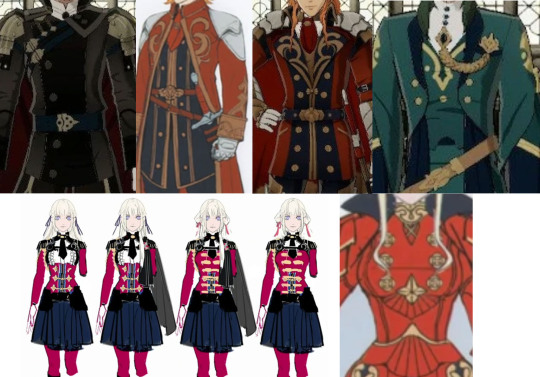
Finally, there's this specific very specific double-breasted neckline thing (baby edelgard is separate bc i forgot to include her when i made the first image shhhh)

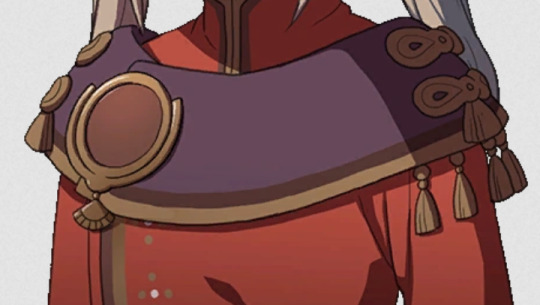
Brief analysis:
Adrestian fashion is all about displaying status and wealth, in this case through ornamentation, rich colors, uniforms denoting class/role, and also a fair amount of excess fabric.
Historically, fabric itself was one of the major indicators of wealth - in fact, certain historical styles very explicitly showed off just who was rich enough to afford, for example, a whole gown made from the same length of fabric, or even just an entire skirt panel with no piecing. In the Adrestian Empire, We've got excess fabric galore, tucked away into all those beautiful ruffles and bell sleeves, layered skirts, unnecessary capes, double collars, and puffy pants - and it's all in much more luxurious colors, too. In fact, I'm pretty sure the largest single piece of fabric on anyone in the game is Edelgard's cape, which is then also adorned with dozens of buttons and extra bits of fabric. It's almost definitely fully silk, both the outer layer and the lining. (And it's badass.)

Look at all that fluff! Dimitri's cloak probably rivals hers in the size of the actual fabric itself, but his is likely a heavy wool (unlined, maybe?), plus has a lot of fur.
"Oh, but pg, there are capes in Faerghus, too!" yes, but in Faerghus, they live in the arctic /hj. Note the vast expanses of exposed skin down here in the empire - clearly, cold is not an issue. You'll also note that the cloaks in Faerghus were heavy and lined with fur; that's not the case here. Given the prevalence of tailored jackets and the dual colors on Ferdinand's cape, I'm guessing they're either a comparatively lightweight wool with a silk lining (typical for tailored suit jackets, nothing particularly noteworthy about that), or just fully silk. (Bernie's shawl is just cotton though, prove me wrong...) Hanneman and Manuela are exceptions, since they both have fur, but they live at Garreg Mach, not in Enbarr.
The jackets themselves, by the way, could be silk OR wool. Ferdinand's in particular (especially thropes) reminds me of early 18th c. waistcoats, which would have been full silk.
We also have much richer colors down here in the land of art and song. Red, purple, and black were all very difficult colors to maintain, and very expensive. The most expensive colors, in fact. Not gonna lie, as far as price per yardage goes, I think Hubert's outfit might rival Edelgard’s in expense.
A notable exception to the excess fabric bit is Bernadetta. However, her dress is in what is arguably the most expensive color, and is heavily decorated, so that's a reasonable trade-off, and I don't blame her. I, too, would go for a smaller amount of pretty purple silk embroidered with bright, beautiful gold and yellow instead of a bigger, more impressive-looking option. It's about the little things.
I do want to take look at Caspar, in particular. He's unique in that he's dressed in a full suit of armor. But, given that he's the second son and not set to inherit anything, unlike all his waistcoat-wearing friends, he isn't being held to some particular uniform, and even if he were, it's the ministry of military affairs. Of course they wear real armor. What's interesting is that his armor is a sort of rosy grey/brass, rather than silver, and he has a lot more decoration and flair than the folks with full armor in Faerghus, in both his throuses and thropes outfits.
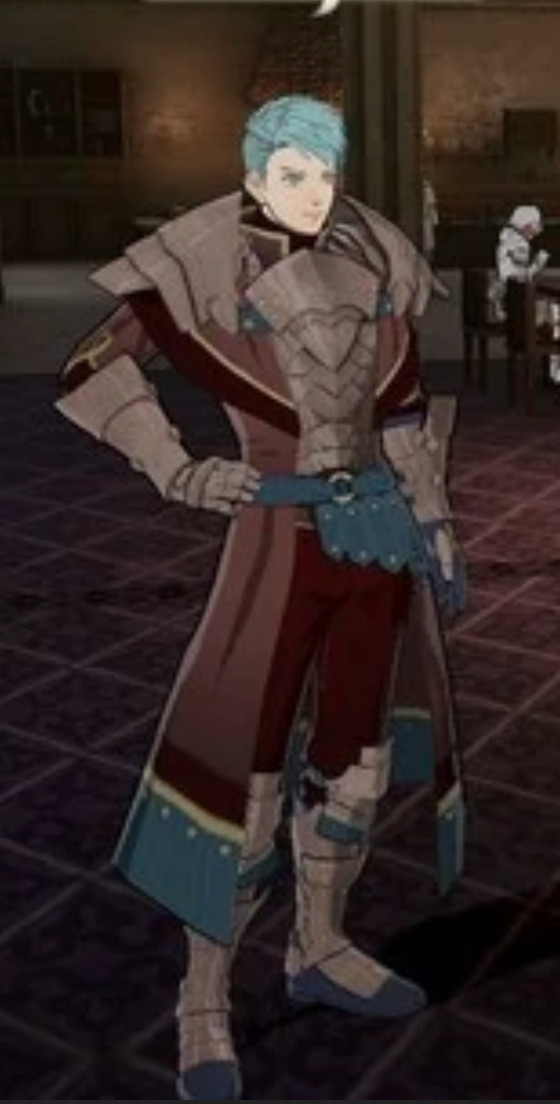

Worth noting, btw, that we have exactly zero examples of actual commoners in Adrestia, other than generic NPCs. Dorothea belongs to that peculiar niche that is opera and acting, so she is expected to dress and act like a noble, despite not having a title or property of any sort.
Adrestia - and Enbarr in particular - leads the slow march of fashion across Fódlan, given that it's a cultural hub and is so much wealthier, while Fearghus slowly picks things up over time. Thus, we have Annette, who lives closer to the empire and has disposable income, having some decorative buttons and tassels and a mock low neckline.


It's not nearly as much as the actual Adrestians, but she's picking it up!
3. Leicester Alliance: the beeeest of both worlds~
Oh, Alliance, you messy bitch. What we see here is a mix of everything, where some of them are influenced by Faerghus, and others by Adrestia (just like how some of them have kingdom-style names and some have empire-style names), and a few fit neither camp. There are clear reasons for similarities where they exist, though, so let's take a look! (Please note: Claude is not included, since his clothes are heavily influenced by Almyra.)
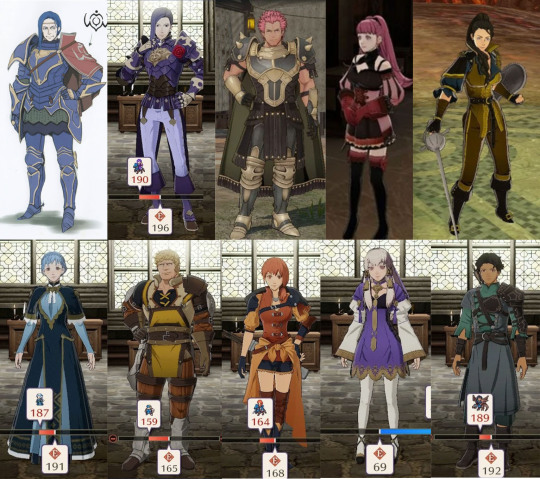
Hilda and Lysithea have the frills, puffy sleeves/skirt, short hems, low/square necklines, and expensive colors of the empire (plus, Lysithea gets a decorative veil in dark purple. How ~fancy~). This reinforces the idea that Adrestia sets the standards for fashion: Hilda cares about fashion and keeps up with the times. Lysithea lives on the border and was briefly under the control of the empire, and thus is influenced by it. Mostly, though, I think it's about how she tries to seem older and tends to see Hilda as a model of maturity (lol), so she's following that example.
Holst's armor is quite decorative, similar to Caspar's, but what stands out to me is the fringe in particular. We see the exact same fringe on Caspar, Hubert, and Edelgard, but not anywhere else.
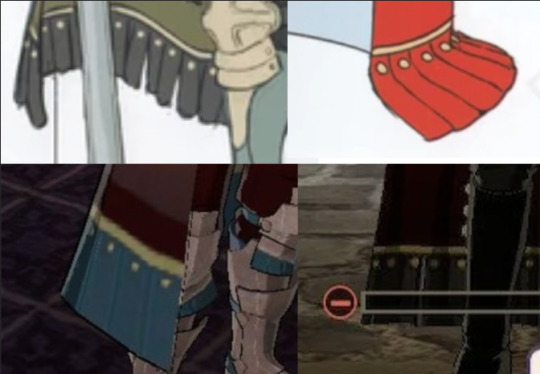
Lorenz and Erwin are a bit of a border case, tbh! They both wear practical, full plate armor with little in the way of extra decor (other than Lorenz's rose and Erwin's little cape thing), but Jesus christ how much does it cost to keep it all so purple like that??? That's a blatant display of wealth that would impress any empire noble.
Marianne, on the other hand, would fit right in in Faerghus, with the old fashioned long skirt, high collar, capelet, and lack of extra decoration other than some pretty trim. Makes sense, since her territory is so close to the kingdom and she's clearly not interested in trying to stay fashionable.
Judith is dressed very practically, has some fun puffy sleeves and bright but inexpensive colors, has a short cape and gambeson (a short vest one, though). I want to say leans toward Faerghus, which makes sense since it's on the border and the house did at one point split off, with part going back to the kingdom.
Now we get to the only real, honest-to-god, never-owned-land-or-property, born-as-and-remain-now peasants/commoners: Leonie and Cyril. (Raphael was born into the merchant class and was able to support himself and Maya by selling his estate, so while we can consider him a real commoner at this point, it's not nearly to the same degree.)
Their economic status is obvious from their outfits: both have very practical clothes with no extra decoration, in cheap and easily accessible colors. Leonie's cloak wrapped around her waist is purely functional - she can use it when the weather calls for it, but it's out of the way of her arrows when she doesn't need it - and looks to be pretty soft, so likely is lightweight. She has a hint of some light protective wear (note the quilted sleeve) and the same front clasps as Felix and Ashe, so i think she's also meant to be wearing a gambeson, but it's shorter and less protective. Cyril doesn't seem to have any armor at all except for the shoulder protection - we can tell from the lack of center-front closures on his shirt and the shape of the cuffs of the sleeves that he's actually just wearing a tunic (or rather, two tunics on top of each other).
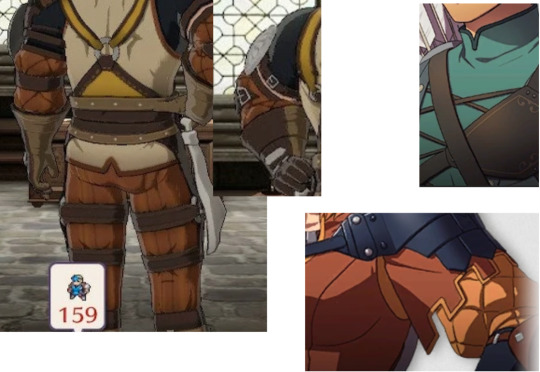
Raphael also has a very practical outfit, but notice that his is so much more protective, probably because he has a little more money than the other two. He has very limited, sparsely placed plate armor, but he is covered head-to-toe in quilted cloth armor. He's ready to get some punching done, baby!
Our real outlier, however, is Ignatz... But you bet your bottom dollar I've got an explanation for that one, too!!!!! Mans is an artist and he has rich(?) merchant parents, he can do whatever he wants.
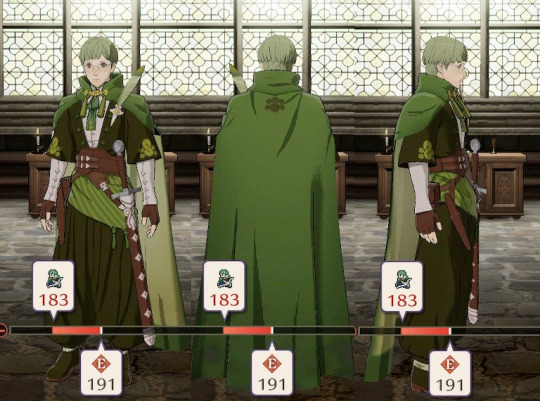
Absurdly unnecessary lengths of (probably not very expensive) cloth? Sure. Fancy feathers that literally no one else gets? Why not! A billion buttons, half of which arent even keeping anything closed? Curly and intricate cloak fasteners probably made of some kind of cording? Sashes and tassels and a decorative sword??? Fuck it, we ball. I love this so much, it's easily my favorite outfit in the entire game and I would ABSOLUTELY wear it irl. I already have the right haircut and glasses and boots, I'm ready
4. In conclusion
These designs really are Fódlan in a nutshell. From the quiet wealth and functionality in Felix's fur-lined gambeson to the audacious luxury of Ferdinand's waistcoat to the unrepentant anarchism of Ignatz's entire vibe, we can see the history - and future - of the continent outlined right before our eyes:
Faerghus is cold, practical, focused on survival, and probably has the most even distribution of wealth. Leicester is a mix of remnants of the empire and kingdom, with clear wealth disparity but also a relatively high amount of social mobility and communal support systems. Adrestia has significantly wealth disparity, with nobles very disconnected from their people and instead busy politicking about.
Side note I know I said I wouldn't go into the historical inspirations, BUT I do think it's interesting that the men's clothing in Adrestia - particularly the tailoring - is similar to much later styles than the men's clothing in Faerghus, and the reverse is true of the women's sleeves and necklines.
Okay that's all, thanks for reading!
#fire emblem three houses#fe3h analysis#holy kingdom of faerghus#adrestian empire#leicester alliance#golden deer#black eagles#blue lions#fodlan's fashion icons#(not actually part of the series but it's topical ok)#this is why i cant do cosplay btw#i see an outfit i like and i immediately am like ok how do you make that irl? get me seven yards of cotton muslin we're doing a mockup#like why would i make Felix’s outfit if I'm not going all in on actual quilted armor yk?#i dont want Ignatz's pants if theyre going to just hang lazily and bunch at the ankle it needs BODY it needs STRUCTURE#yk?#anyway its super late im going to bed now bye#fashion in fodlan
2K notes
·
View notes
Text

PEDRI in Collaboration with AUDEMARS PIGUET - BARCELONAS GOLDEN BOY
Similarly, Pedri grew up in the mountainous municipality of Tegueste in the Canary Islands, surrounded by natural beauty. Spending hours near the sea playing football with his brother and friends, he has experienced the joys of the planet and its beauty before entering a life of football, fashion and bright lights. But a profound sense of where he has come from remains, and humility and humbleness continue to lead the 21-year-old’s choices.
His recent collaboration with Platano De Canarias, an institutional brand fighting malnutrition through the promotion of bananas, is a testament to that. The banana is the most important crop in the Canary Islands and for decades, the industry has been the protagonist of the economic growth of the archipelago – accounting for 60% of Europe’s banana production. He is also an ambassador for Kick Out Plastic, a non-profit international campaign fighting for a world free of plastic pollution and climate change.
“Climate change is something that affects us all and should concern us all, especially young people,” Pedri explains. “Sustainability and recycling are part of my daily life because my parents instilled it in me since I was a child. Being from a natural paradise like the Canary Islands, which also lives mainly from tourism, I am very aware of the importance of taking care of nature for all of us.”
As a 21-year-old with over 13 million followers on Instagram, you might not expect such issues to be on Pedri’s radar. Yet he is acutely aware that he not only has the world at his feet but in his hands — a gift he has no intention of wasting.
Intelligent, humble, and grounded, Pedri represents the younger generation with flying colours. He is a role model to all those who find themselves lucky enough to share his position and an indication that the high-profile figures at the forefront of modern football might just have deeper purposes.
On the pitch, Pedri has been hailed like no other — ‘One of the world’s best’ in the opinion of Barcelona’s manager Xavi Hernández, and ‘The signing of the decade’ according to Marca, Spain’s leading sports news outlet.
Lionel Messi’s final campaign in the famous red and blue hoops of Barça didn’t quite live up to expectations but offered an exciting window into what could be. Pedri was fresh on the scene; quiet, innocent, slight in figure and polite in persona; terrorising defences with a low centre of gravity, immense skill, close control and vision. His personality and playing style drew obvious comparisons to the iconic Argentine with whom he had struck up quite the partnership on the field. By all accounts, Barça’s next messiah was born.
But the story of a wunderkind is rarely so simple. Following his move to Barcelona and The Kopa Trophy win, he played a staggering 73 games and over 4,000 minutes in less than a year and subsequently suffered a string of injuries that would leave him out of the side for months at a time. While he has since returned to the team and reasserted his peerless playmaking form, the issue of over-played, over-pressured, fatigued young players falling victim to a demanding fixture schedule remains a pressing problem with the modern game.
“Professional football is very, very demanding, not only physically but mentally too,” Pedri admits. “I try to face things professionally and prepare myself to always be in optimal condition. That’s why it’s even more annoying when an injury forces you to stop and start all over again.
“In difficult moments, my brother Fer — the person I love the most in this life — is the one who protects me and is always by my side. I like to spend my days off at home with him and my family, watching TV series, playing board games and enjoying their company.
At first glance, Pedri appears to be an ordinary young man, but one who is poised on the brink of greatness. As the bricks for the new Camp Nou are laid one by one, Pedri is quietly constructing his own empire, drawing support from family, friends, and his sheer love for football.
“I am who I am because of my parents,” says Pedri. “They raised me with very clear values: you must be humble and respect everyone. I live my life by a quote from the legend Johan Cruyff, ‘Salid y disfrutad’ which means to ‘go out and enjoy’, and I think that sums up my approach to life.”

81 notes
·
View notes
Text
New pre-history-related discovery in Euskadi: evidences of mass warfare in Europe 1,000 years prior to previously thought.

Previous research suggested that conflicts during Neolithic consisted of short raids, lasting no more than a few days and involving small groups of up to 20-30 individuals. As a result, researchers assumed that Neolithic societies lacked the logistical capabilities to support larger-scale conflicts. But the results of the latest study have challenged this view.
To investigate this conflict in the Neolithic, the authors of the latest study re-analyzed remains found at the San Juan Ante Portam Latinam rock shelter (Guardia, Araba), which was discovered accidentally in 1985 when a bulldozer was widening a track and uncovered human remains.
Subsequent rescue excavations identified the remains of at least 338 individuals that have been dated to between roughly 5,400 and 5,000 years ago. These people were buried together in a haphazard way, with the bodies found interwoven with each other—some in unusual positions. The remains were found together with 52 flint arrowheads, 64 blades, two polished stone axes, and other artifacts.
Many of the remains—which include both complete and incomplete skeletons—displayed evidence of arrowhead injuries, while researchers also found a single example of unhealed trauma to the skull, or cranium.
Original interpretations of the mass burial site suggested that the individuals found there were a) buried during a 200 years period or b) slaughtered in a massacre—i.e. the indiscriminate killing of helpless or unresisting people. But subsequent studies have challenged previous interpretations suggesting that many of them died in one or more violent conflicts.
The re-examination of the SJAPL remains in the latest study was aimed at identifying new evidence of violence on the bones: they found that males were disproportionately affected by injuries, while also observing an unusual high rate of healed injuries overall.
The bones provided evidence of re-occurring and varied violent events—for example, some individuals showed both healed and unhealed injuries suggesting repeated exposure to violence, while evidence of arrowhead injuries and cranial traumas indicate that they were involved in different types of combat. The remains also suggest that these people experienced social unrest and difficult life conditions, showing signs of malnourishment, anemia and other conditions.
But what was the conflict?
"We think we are seeing the result of a regional inter-group conflict. We suggest that resource competition and social complexity could have been a source of tension, potentially escalating into lethal violence" said Fernández-Crespo the author of the study affiliated with the University of Valladolid, Spain, Aix-Marseille University, France, and the University of Oxford, U.K
"We can conclude that warfare in the Neolithic was much more sophisticated, organized and with the potential to affect the general population than previously thought, which means that there was necessarily a greater socio-economic hierarchy than previously assumed. The study provides evidence of larger-scale, more organized and longer-lasting conflict than previously suspected for the Neolithic, to an extent that had not been observed until 1,000 years later during the Bronze Age."
[x]
#euskal herria#basque country#pays basque#pais vasco#euskadi#pre history#history#archaeology#anthropology#news#discovery#wow#europe
163 notes
·
View notes
Text
Explaining PIP, the reforms and how YOU can help!
Recently, Prime Minister Rishi Sunak and Secretary of State for Work and Pensions Mel Stride announced measures to reform PIP (Personal Independence Payment). It's a benefit given to disabled people, whether they are employed or not, to help provide support for the extra costs incurred due to being disabled. PIP can be paid on anything you need, such as a carer, adaptions, your bills or a night out (yes, disabled people are entitled to a social life I'm NOT arguing with anyone about this!) On top of the changes to sick notes, the announced reforms are an assault on disabled people to desperately cling to power!
Below is an explanation of PIP and the reforms so people can answer the open consultations, call for evidence, and sign a petition. We need as many people in the UK as possible to answer both to try to stop these reforms from happening.
What is PIP?
The Tories are saying PIP is a one-size-fits-all benefit, which again is a lie as PIP is designed to look at how your disability affects your daily life and how difficult it makes it for you to participate in society, not whether you have this specific disability so it only affects you in these ways! It doesn't matter whether you're diagnosed or not, either. There are two categories they look at throughout, known as the 'Daily Living Component' and the 'Mobility component' The process involves 50 pages you have to fill out (link to Turn2US for proof https://www.turn2us.org.uk/get-support/information-for-your-situation/claiming-personal-independence-payment-pip/fill-in-the-personal-independence-payment-pip-form#:~:text=You%20usually%20get%20the%20paper,it%20is%2050%20pages%20long.)
With hundreds of letters from Doctors as proof of your condition! And then an assessment in which you will answer all sorts of demeaning questions, give in-depth answers that you don't feel comfortable sharing, and hope the assessor has understood how it affects your life and written it down properly and that you'll get the right amount of money at the end of this assessment or re-assessment.
To get the standard rate in both components, you need 8 points; to get the enhanced rate, you need 12 points.
They'll then give you two, three, five, or ten years (10 years is known as a fixed-term award and a light-touch review) to undergo the terror of the PIP assessment again.
The reforms proposed and why they're terrifying!
The reforms they've suggested so far are
One-off grants for aids and appliances
receipts to then be claimed back at a later date
the changing of eligibility for PIP or the category 'Long Term sickness'
Vouchers instead of cash payments
If you've read those four options and thought they were cruel, infantilising and impossible to make work, then you'd be right.
As a disabled person, bills don't magically disappear. You still have council tax and rent to pay or a carer. Will landlords and councils accept these vouchers? A one-off grant won't work here either. The vouchers also signal that we can't be trusted to pay for our own needs and aren't responsible—which is far from the truth!
Aids and treatments are already covered by the NHS, so this is redundant and will be futile, especially when you consider the long waiting lists for mental health treatment (and just generally) on the NHS—and even if they aren't, we do know that and will use PIP to save up for it, etc. It's easier and more economical to give us cash payments.
To have the receipts to claim back expenses, we need to have the money to spend on said expenses.
Changing the eligibility will (much like these other suggestions) put more disabled people at risk. If you want mental health to improve: Fix the NHS, wages, sort out the cost of living crisis and fund the research/support for Long Covid sufferers.
How you can help! - UK-based people, plz sign everyone else. Please reblog & signal boost!
If you live in the UK, there are currently two consultations open ( the sick note one closes on 8 July 2024, and the PIP one closes on 22 July 2024). Ideally, the responses will be used to decide whether these reforms go ahead.
Here are links to the two reforms for PIP and changes to the sick note process.
Please note that the PIP consultation ( the first link) is 6 pages long and must be completed in one go. It's also filled with typos, repeated questions, and very difficult wording in many places, so be on the lookout for that! People are rightfully complaining about its accessibility, so the link and end date may change. I will update this post if this happens. I also know answering stuff like this is overwhelming, so here is a thread by PeachyInWales on Twitter about how they approached the consultation. If I see any samples by any disability activists or organisations, I will post them here, too!
This second link is the second consultation or call to evidence. Which GPs are being stripped of the ability to sign sicknotes for people on benefits, which is again ridiculous!
And the last link is a petition from SCOPE to stop the government from demonising disabled people further.
Ultimately, we're trying to stop a benefit that is difficult to get and barely covers costs for many applicants from getting worse.
If I've missed anything then let me know! I'm sorry the post was so long, but it's a lot to go through! Again, UK-based people, please share your thoughts if you can and sign the petition! If you are not currently living in the UK, please share these links or the post so other UK-based users can see this and try to help.
Thank you!
#uk politics#anti rishi sunak#anti mel stride#anti dwp#PIP#personal independence payment#sick notes#petitions#UK benefit reforms#disability rights#disability activism#disability#SCOPE#anti tories
60 notes
·
View notes
Text
"You're the last pure thing I know."
"Maybe there's more truth in the human condition to me taking my clothes off for emotionally stunted men so that my grandmother can shit in a bag, than me staying virginal and pure for you."
"Well if you must... I'm gonna watch."
Zombie Strippers seems to be satirically hitting on some difficult truths about economic hardship in the USA in ways that people like to attribute to Idiocracy, but I think about 75% less ironically patronizing towards its audience. Worldbuilding wasn't really something I expected from a movie titled Zombie Strippers.
122 notes
·
View notes
Text
(...)
"Set the scene for us: what is the ICJ, and why is the hearing taking place there?
The 1945 UN Charter — signed by all UN members, including Israel — affirms that the ICJ is the UN’s supreme legal organ. The Constitution establishes two powers for the Court: issuing advisory opinions, and ruling in cases between states. The Court’s verdicts are binding on the states that have signed the UN Constitution. A state can agree in an ad hoc manner that a particular dispute will be litigated by the ICJ, or invoke signed treaties containing a clause that establishes ICJ jurisdiction over disputes relating to those treaties.
Israel has always had reservations about the jurisdiction clause, and has refrained from agreeing to ICJ jurisdiction in all the hundreds of treaties it has signed, except one: the Genocide Convention. Article 9 of the Convention stipulated that if disagreements arise between the members over the Convention’s authority or interpretation, the ICJ is the place to hear them.
ICJ decrees are enforced by the UN Security Council. Chapters 6 and 7 of the UN Charter allow for a range of sanctions against countries that violate the Court’s ruling, such as economic sanctions, arms embargoes, and military intervention. The latter is rare but it has happened, for example in the first Gulf War.
Why did Israel sign up to ICJ jurisdiction in the Genocide Convention?
I’m not a legal historian; I can only guess. Israel was one of the initiators of the treaty, and historically one can understand why Israel would have pushed for such a treaty in the late 1940s and early 1950s. Secondly, I think that back then, the popular Israeli notion that we do not let gentiles judge us had not yet developed. We are talking about an era in which the international system had recently decided to establish a Jewish state. Maybe there was a little more trust in that system back then.
What constitutes a violation of the Convention?
(...)
It is defined as an act of extermination, or creating conditions that will annihilate a particular group with the intention of eradicating that group or even a distinct part of it.
The Convention, which was integrated into Israeli law in 1950, states that a soldier or civilian who kills a person, even one, while aware that he is part of a system aimed at annihilation, is guilty of the crime of genocide. In Israeli law, the punishment for this is the death penalty. This also applies to those who conspire to commit genocide, those who incite genocide, and those who attempt to participate in genocide.
What is South Africa basing its lawsuit on?
South Africa bases its accusation on two elements. One is Israel’s conduct. It cites a great deal of statistics about the indiscriminate, disproportionate attacks on civilian infrastructure, as well as about starvation, the huge number of casualties, and the humanitarian catastrophe in the Strip — horrifying statistics that the Israeli public is barely exposed to, because the mainstream media here does not bring them to us.
The second and more difficult element to prove is intent. South Africa is trying to prove the intent through nine dense pages of references to quotes by senior Israeli officials, from the president to the prime minister, government ministers, Knesset members, generals, and military personnel. I counted more than 60 quotes there — quotes about eradicating Gaza, flattening it, dropping an atomic bomb on it, and all the things we’ve gotten used to hearing in recent months.
South Africa’s case does not rely only on the fact that some Israel leaders have made genocidal statements. It further charges that Israel has done nothing in response to these statements: it hasn’t condemned the statements, it hasn’t dismissed from office the people who expressed them, it hasn’t opened disciplinary proceedings against them, and it certainly hasn’t opened criminal investigations. This, as far as South Africa is concerned, is a very strong argument.
Even if we haven’t heard the IDF Chief of Staff or the General of the Southern Command say these things, and we don’t have an operational order that says, “Go and destroy Gaza,” the very fact that these statements have been made by senior Israeli officials without sanction or condemnation sufficiently expresses Israel’s intention.
South Africa also pulled a little legal stunt to get here, correct?
Yes. The jurisdiction of the Court is determined when a dispute arises between the parties over the interpretation or application of the Convention. South Africa sent several letters to the Israeli government saying, “You are committing genocide.” Israel responded, “No we aren’t.” So South Africa said, “Okay, we have a dispute over the interpretation of the Convention.” That’s how it got the authority.
What can we learn from similar ICJ cases in the past, such as those regarding genocides in Bosnia and Myanmar?
First of all, we know from these cases that the burden of proof on South Africa is significantly lower for obtaining an interim order than for ultimately proving that Israel is committing genocide. We also know that this case will continue for years: the Bosnia case took 14 years; Gambia v. Myanmar is still ongoing. But the procedure for an interim order is fast.
Gambia filed its case against Myanmar on behalf of the Organization of Islamic States. It asked for an interim order stating that Myanmar must cease its military operations [against the Rohingya people]. The Court ruled that at this stage of the hearings, it did not need to determine whether the crime of genocide had been committed. What it needs to decide is whether, without an interim order, there is a real danger that the prohibitions set out in the Genocide Convention will be violated.
An interesting interim order was issued in that case, which I think has a good chance of being issued to Israel as well — not in the context of military activity, but of incitement. The Court’s order also required Myanmar to take enforcement actions and submit reports to the ICJ and Gambia on what it was doing to prevent genocide. As for the cessation of Myanmar’s military activity, this matter went to the Security Council, where both Russia and China threatened vetoes, but Western countries imposed sanctions and a military embargo anyway.
So even if South Africa fails to make the Court issue an interim order to stop Israel’s military activity, it could be that in the context of incitement — which enjoys full immunity in Israel — the Court will say that Israel needs to do something.
(...)
I know lawyers don’t like to wager on the results of court hearings, but if the ICJ does produce an interim order, what will that mean for Israel?
If the Court issues an order, the question is of course whether Israel will obey it or not. Knowing Israel, I expect that it will not obey the order, unless it can present the ending of hostilities as the result of its own independent decision, unrelated to the Court order.
There are good reasons for Israel to do this, because disobeying an ICJ order brings things to the UN Security Council. It’s true that the United States has a veto there, and therefore a resolution to impose sanctions on Israel would most likely be blocked. But vetoing an ICJ order regarding concerns that genocide is taking place would come at an enormous political price for the U.S. government, both domestically and internationally.
The Biden administration wants to portray itself as a government that sees human rights as one of its pillars. So it is likely that the United States would only veto such a resolution while imposing a significant cost on Israel in order to justify doing so, such as allowing the residents of northern Gaza to return to their homes, or entering into negotiations over two states — I don’t know.
But even if the United States doesn’t use its veto in that scenario, an interim order from the ICJ is likely to cause Israel serious problems.
There is such a thing as an international legal “deep state.” Jurists and judges listen to what important courts say. And when the ICJ, also known as the World Court, makes its rulings, national courts in most of the Western world take note. Therefore, if the ICJ rules that there is a danger of genocide being committed, I can imagine a British citizen turning to a British court and demanding that the UK cease trading arms with Israel. Another implication is that such an ICJ ruling would likely force the ICC’s chief prosecutor [Karim Khan] to open an investigation of his own.
(...)
Within what time period is the Court’s decision expected?
There are no set rules, but in the Gambia v. Myanmar case, there was a decision within a month. It should be remembered that this [Gaza] case will continue after the hearing on the interim order. Israel will have to present evidence that will exonerate it from the claim that it is committing genocide, but in doing so could get into difficulties with the ICC. For example, it may explain that it bombed a certain place because it was pursuing a military objective, but it may thereby make admissions that create a basis for the claim that it used disproportionate force."
...
#israel#palestine#icj case#genocide#didn't expect the interviewed to mention being the grandson of sociologist zygmunt bauman
130 notes
·
View notes
Text
Some thoughts on gentrification discourse:
There is a school of thought which says that gentrification is the result of desirable conditions of economic freedom. As more people want to move into a neighborhood, the price of housing will naturally go up because demand is higher. The people willing to pay these higher prices are naturally going to be the people who most want to live there, and so the market is efficiently allocating the limited space that exists in cities to the people who most desire it. It may be unfortunate that the people who already live there are priced out of their homes by this process, but ultimately it's for the better, and an example of markets working as intended.
Of course, there is the obvious caveat that this viewpoint ignores: that willingness to buy an item at a given price is only an effective proxy for "who wants the item most" if everyone has the same amount of money. As long as people's wealth varies considerably, how much someone is willing to pay for something is not necessarily a good cross-subject measurement of how much the thing is desired. The efficiency of price rationing as a distribution scheme is inversely related to the amount of wealth inequality there is, and in our present society there is a lot.
On just these grounds we might take gentrification as at least potentially very unjust in any given case, if not necessarily so.
But I think there's another factor that's often overlooked in these discussions, which is the breaking up of communities. I think that people get a huge amount of illegible and difficult to price value out of community ties and lasting social relationships. Not everyone does, some people are more inclined to solitariness or more inclined by personality to atomic life than others. But I think that most people do. I also think (and know by experience) that suddenly loss of one's community can be an actively traumatic event.
That is to say, I think the good in "getting to continue living where you are already living" is systematically underestimated by people who talk about gentrification as an economic issue, and the harm in "suddenly having to leave where you are living and go elsewhere" is likewise systematically underestimated.
As a more controversial claim, I will say that this is why I am more sympathetic to rent control than most economically informed people (to be clear I am not deeply economically informed, my knowledge of economics is very moderate). The general critique of rent control is that it entrenches current residents against people who would like to move there, and I think this may not be as bad of a thing as it is generally presented as being. But I gather there are other problems with rent control related to the incentives around housing construction, which I don't know much about and won't comment on.
64 notes
·
View notes
Text
My name is Mahmoud Hammad from Palestine, Gaza. I finished my studies in nursing. I worked as a volunteer in one of the hospitals in the Gaza Strip, “Nasser Medical Hospital” in Khan Yunis, and after that I worked in a field outside my university studies due to the economic conditions and the siege on the Gaza Strip. “I want your help to save my family from this brutal war, and I am asking for your support to help me rescue my family (my parents, my wife, my two children, and three brothers) from Gaza. For more than 130 days, we have witnessed very difficult days of bombing, destruction, fear and terror. I lived days without I know news. My family has been cut off from communication due to the massive destruction and bombing. My family was displaced under bombing and terrorism to Rafah. We have reached a stage where we feel desperate. I ask you to help me save my family’s life by getting them out of Gaza because there is no safe place, and people are slowly dying because of... Hunger and dehydration. Displacement, the spread of diseases and malnutrition. My family became homeless like many others due to the ongoing bombing of Gaza since October 7. When my family was displaced, there was no means of transportation to get around. They walked under the bombing with fear and panic in their hearts. My family is staying now in a tent in Rafah in bad conditions. It is absolutely inhumane, food is running out, there is no electricity, water or toilet and it is very cold, imagine no diapers for my children! It has been 3 months of hell and horror. This genocide has been going on for a while for a long time, our mental health and our lives are in constant danger. This is what I can describe, and I cannot talk about the horrific scenes that my family witnessed throughout this period. We have reached a point where there is no longer any hope for us here in Gaza because unfortunately we are waiting for our turn to die.
The destruction in Gaza is too great to rebuild quickly. To exit Gaza through the Gaza crossing, which is the only crossing in the Strip, an adult must pay $7,000 to the coordinator. The occupation has destroyed a very large number of homes in our camp and bulldozed all the streets, and now we know nothing about our home!, which I miss and my eyes shed tears without realizing it. My entire childhood and childhood memories were lived in that house.
Please help me, I would greatly appreciate any donation, even a small one that can make a huge difference in alleviating our suffering. Please share my campaign widely, because every minute is a risk of death in Gaza. I would appreciate your help during this difficult time.
Thank you for standing in solidarity with us.
Mahmoud from Palestine - Gaza



81 notes
·
View notes